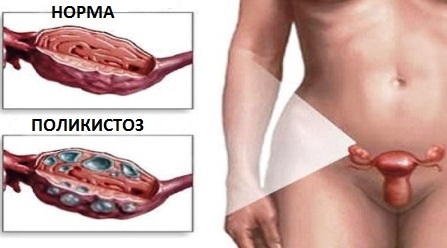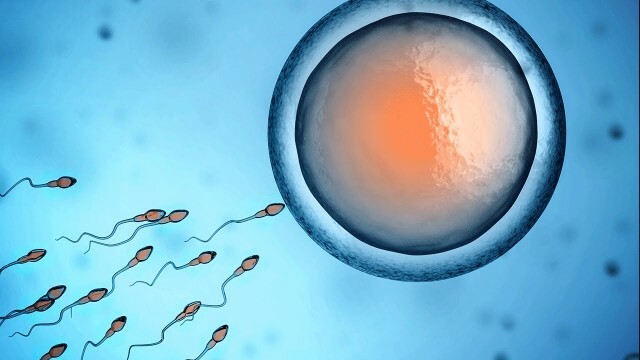Multifollicularity of the ovaries( polycystic) is a gynecological disease, which involves the formation of a number of simultaneously ripening during the menstrual cycle of equivalent follicles. This leads mainly to the fact that none of them is able to properly develop and burst with the release of the egg. The result can be a prolonged inability of a girl to become pregnant, which often becomes a problem for the family.
Causes of polycystic ovary

Normally, several( 2-3) secondary and 1 dominant sac with the sex cell of a woman are usually formed, and on the 14-16th day of the cycle it is ruptured and an egg ready for conception emerges from it. This is called ovulation. These days the woman most likely can become pregnant. In case of polycystosis such sacs can be 12-15.
This disease can not be called too common. According to official statistics, only about , 5% of the fair sex are infected with .Nevertheless?it is necessary to understand why and when it can manifest. The main causes of polycystosis are:
- Use of hormonal contraceptives. Artificially suppressing the process of ripening of follicles, it is possible to introduce a serious imbalance in the hormonal background, which in the future can easily lead to the development of the disease;
- Lactation of the mother after the birth of leads to an increase in the level of prolactin in the blood, which physiologically reduces the activity of follicle-stimulating hormone, and as a result - the development of multi-follicularity;
- Stress. The constant nervous tension affects the release of the hormones corresponding to the menstrual cycle. In a simple way, the physiological rhythm is lost, and the follicles grow incorrectly;
- Sharp weight loss. Lack of nutrients adversely affects the whole body and the ovaries in particular;
- Any endocrine diseases ;
- Obesity and early onset of menstruation. In both cases, there is an excess of sex hormones, which introduce randomness into the glands of a woman.
Polycystosis and pregnancy
In addition to knowing the mechanism of development of pathology and the main reasons, most potential mothers are interested in the possibility of conception of a child with such a diagnosis. After all, one of the main and most unpleasant symptoms is infertility.
But do not be discouraged. You can get pregnant! Of course, this depends on the individual characteristics of each woman and her body, the nature of the pathology and associated diseases. Very there are often situations when young ladies with such a diagnosis become pregnant without any auxiliary therapy or medical interventions .But there are cases when, to achieve a coveted result, you need to turn to the doctor and undergo a course of adequate treatment.
Treatment of multifollicularity of the ovaries
Conditionally all the methods of therapy can be divided into 2 large groups:
- medicamentous;
- operational.
Depending on the desire of the woman and the recommendations of the attending physician, one can choose one or another method of healing or a combination thereof.
The first method involves using drugs to stimulate ovarian function with activation of follicle growth and their proper functioning .It is worth noting that before the treatment, a woman is given a year for the natural conception of the baby. If during this time with regular sexual life does not become pregnant - the process of medical intervention begins.
The most commonly used drugs for polycystic therapy are:
Oral hormonal contraceptives

Strangely enough, and wildly it sounds, but it is the reception of such medications that can normalize the impaired menstrual function and start the proper process of ovulation. As they say: "a wedge knock out a wedge". But the positive effect comes only after the end of the course of therapy, which can last from 6 to 12 months. You need to be ready for a long recovery. Medications that are popular with gynecologists:
- Jess;
- Jarina;
- Diana 35 and other analogues.
Medications for ovulation stimulation
Medications for ovulation stimulation are a group of drugs whose main task is hormonal stimulation of oocytes in the follicles, which leads to increased growth and rupture within a certain time. A prerequisite for using such tools is reception on specific days of the cycle. Preparations:
- Clomifene( Clomid, Clostilbegit);
- Chorionic gonadotropin( Horagon, Pregnil);
- DUFASTON.
The most common scheme of drug use:
- From the 5th to the 9th day, take Clomiphene or analogues.
- Monitoring of follicle growth, endometrium with ultrasound from 11-13 days. When you reach the desired size( 18 mm), you can go to the next stage of therapy. This usually happens on the 14-16 day of the cycle.
- A chorionic gonadotropin injection to stimulate the rupture of the follicle membrane. Ovulation occurs on average 24 hours after intramuscular injection.
- Sexual act on the day of injection and the next day.
- Using Dufaston from day 16 for adequate functioning of the yellow body for 12-16 days. Then repeat the sonography of ovaries to determine the next ovulation.
Siofor
Metformin( Siofor) does not apply to purely gynecological drugs. It is used primarily for the treatment of type 2 diabetes mellitus. But the practice of its use has shown a good result in the treatment of polycystic ovaries. Until now, no precise mechanism for influencing the reproductive system of women has been established, but many cured representatives of the fair sex confirm its effectiveness. It is recommended that Metformin be used only if there is concomitant insulin resistance.
Surgical treatment of
The main method of surgical intervention, which is used in multifollicular ovaries, is laparoscopic drilling. Its essence is very simple:
- in the woman's abdominal cavity 2 tubes are inserted through small incisions of the skin;
- uses carbon dioxide to prepare the operating field;
- with the help of special tools make small punctures of the ovary capsule and their elimination.
Thus, at once 2 main goals are achieved:
- through the created holes the mature eggs freely come out - the process of ovulation is greatly simplified;
- decreases the level of androgen male hormones. It is in the capsule of sexual glands that their active synthesis occurs.
After carrying out such an operation, which lasts approximately about 1 hour under systemic anesthesia, a woman has every chance to conceive a baby for the next cycle.



